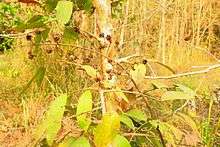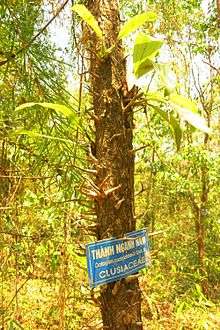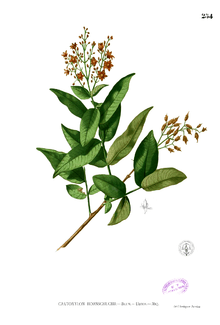Cratoxylum cochinchinense
Cratoxylum cochinchinense (or Cratoxylon cochinsinensis (Lour.) Blume, an orthographic variant often still used in Vietnam, where the species was described[5]) is a plant now placed in the family Hypericaceae. The specific epithet cochinchinense is from the Latin meaning "of Cochinchina".[3] In Vietnamese C. cochinchinense is usually called thành ngạch nam[5] or lành ngạnh nam, other names include: hoàng ngưu mộc, hoàng ngưu trà and đỏ ngọn.
| Cratoxylum cochinchinense | |
|---|---|
 | |
| Dehiscent seed capsules, leaves and trunk: Cat Tien National Park specimen | |
 | |
| Characteristic trunk of young tree (with epiphytic orchids) | |
| Scientific classification | |
| Kingdom: | Plantae |
| Clade: | Tracheophytes |
| Clade: | Angiosperms |
| Clade: | Eudicots |
| Clade: | Rosids |
| Order: | Malpighiales |
| Family: | Hypericaceae |
| Genus: | Cratoxylum |
| Species: | C. cochinchinense |
| Binomial name | |
| Cratoxylum cochinchinense | |
| Synonyms[2][3][4] | |
|
Ancistrolobus ligustrinus Spach | |
Description
Cratoxylum cochinchinense grows as a shrub or tree, typically measuring 10-15 metres (49 ft) tall with a diameter of up to 0.65 metres (2 ft 2 in). The brown bark is smooth to flaky, with characteristic lateral pegs which are the remnants of previous leaf clusters (see illustration); leaf undersides are glaucous.[5] The flowers are crimson red, which develop into seed capsules measuring up to 12 mm (0.5 in) long.[3]
Distribution and habitat
Cratoxylum cochinchinense grows naturally from southern China to Borneo. Its habitat is sub-tropical and tropical forests, including kerangas forests and peat swamps.[3]
Gallery
References
- World Conservation Monitoring Centre (1998). "Cratoxylum cochinchinense". IUCN Red List of Threatened Species. 1998: e.T33936A9823214. doi:10.2305/IUCN.UK.1998.RLTS.T33936A9823214.en.
- "Cratoxylum cochinchinense (Lour.) Blume". The Plant List. Retrieved 14 March 2017.
- Wong, K. M. (1995). "Cratoxylum cochinchinense (Lour.) Blume". In Soepadmo, E.; Wong, K. M. (eds.). Tree Flora of Sabah and Sarawak. (free online from the publisher, lesser resolution scan PDF versions). 1. Forest Research Institute Malaysia. pp. 222, 223–224. ISBN 983-9592-34-3. Archived from the original (PDF) on 27 September 2013. Retrieved 14 July 2014.
- "Cratoxylum cochinchinense". Germplasm Resources Information Network (GRIN). Agricultural Research Service (ARS), United States Department of Agriculture (USDA). Retrieved 14 July 2014.
- Phạm Hoàng Hộ (1999) Cây Cỏ Việt Nam: an Illustrated Flora of Vietnam vol. I publ. Nhà Xuẩt Bản Trẻ, HCMC, VN
External links
| Wikimedia Commons has media related to Cratoxylum cochinchinense'. |
| Wikispecies has information related to Cratoxylum cochinchinense |

